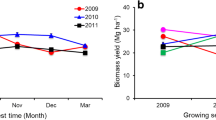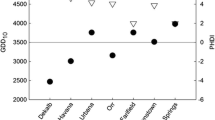Abstract
Bamboo and Miscanthus species are perennial low-input plants that are excellent candidates for bioenergy feedstock production. Biological characteristics, dry matter yields and fuel properties of the bamboo and Miscanthus have been studied. Genotype growth characteristics were determined by measurements of plant height, tillering, tuft diameter, and shoot diameter. To date, comparisons of biomass yields of bamboo and Miscanthus have not been previously reported in the literature. Bamboo and Miscanthus species were collected and previous articles describing the productivity of bamboo and Miscanthus were examined. Genotypes differed in plant height, tillering, tuft diameter, and shoot diameter. Nitrogen, temperature, water and plant density have effects on mature stands biomass production, which ranged from 5.9 to 49.5 tonnes/ha/yr for bamboo and 3.2 to 49.0 tonnes/ha/yr for Miscanthus. With such biomass yields, bamboo and Miscanthus should be considered as two very promising plants for biomass production in Zhejiang, China in the near future.
Similar content being viewed by others
Literature Cited
An, Y., B. Zhou, C. Wen & G. Wang. 2009. Effects of Different Management Patterns on Root System Structure and Biomass of Bambusa oldhami. Forest Research 22(1): 1–6.
Bagby, M. O., G. H. Nelson, E. G. Helman & T. F. Clark. 1971. Determination of lignin in non-wood plant fiber sources. Tappi Journal 54: 1876–1878.
Benbi, D. K. & J. S. Brar. 2009. A 25-year record of carbon sequestration and soil porperties in intensive agriculture. Agronomy for Sustainable Development 29: 257–265.
Ceotto, E. 2008. Grasslands for bioenergy production. A review. Agronomy for Sustainable Development 28: 47–55.
Clifton-Brown, J. C. & I. Lewandowski. 2001. Screening Miscanthus genotypes in field trials to optimise biomass yield and quality in Southern Germany. European Journal of Agronomy 6: 97–110.
———, S. P. Long & U. Jorgensen. 2001. Miscanthus productivity. Pp 46–67. In: M. Jones & M. Walsh (eds). Miscanthus for energy and fibre. James and James, London, UK.
———, I. Lewandowski, F. Bangerth & M. B. Jones. 2002. Comparative responses to water stress in stay-green, rapid- and slow senescing genotypes of the biomass crop, Miscanthus. New Phytologist 154: 335–345.
———, P. F. Stampfl & M. B. Jones. 2004. Miscanthus biomass production for energy in Europe and its potential contribution to decreasing fossil fuel carbon emissions. Global Change Biololgy 10: 509–518.
Cosentino, S. L., C. Patane, E. Sanzone, V. Copani & S. Foti. 2007. Effects of soil water content and nitrogen supply on the productivity of Miscanthus x giganteus Greef et Deu. in a Mediterranean environment. Industrial Crops and Products 25: 75–88.
Danalatos, N. G., S. V. Archontoulis & I. Mitsios. 2007. Potential growth and biomass productivity of Miscanthus x giganteus as affected by plant density and N-fertilization in central Greece. Biomass & Bioenergy 31: 145–152.
Dence, C. W. 1992. The determination of lignin. Pp 35–57. In: S. Y. Lin & C. W. Deuce (eds). Methods in lignin chemistry. Springer, Berlin.
Embaye, K., M. Weih, S. Ledin & L. Christersson. 2005. Biomass and nutrient distribution in a highland bamboo forest in southwest Ethiopia: implications for management. Forest Ecology and Management 204: 159–169.
Ercoli, L., M. Mariotti, A. Masoni & E. Bonari. 1999. Effect of irrigation and nitrogen fertilization on biomass yield and efficiency of energy use in crop production of Miscanthus. Field Crops Research 63: 3–11.
Fengel, D. & G. Wegener. 1984. Pp 56–59. Wood: chemistry, ultrastructure, reactions. Walter de Gruyter Publishers, Berlin.
Hastings, A., J. C. Clifton-Brown, M. Wattenbach, P. Stampfl, C. P. Mitchell & P. Smith. 2008. Potential of Miscanthus grasses to provide energy and hence reduce greenhouse gas emissions. Agronomy for Sustainable Development 28: 465–472.
Higuchi, H. 1957. Biochemical studies of lignin formation, III. Physiologia Plantarum 10: 633–648.
Isagi, Y., T. Kawahara & K. Kamo. 1993. Biomass and net production in a bamboo Phyllostachys bambusoides stand. Ecological Research 8: 123–133.
———, ———, ——— & H. Ito. 1997. Net production and carbon cycling in a bamboo Phyllostachys pubescens stand. Plant Ecology 130: 41–52.
Jeżowski, S. 2008. Yield traits of six clones of Miscanthus in the first 3 years following planting in Poland. Industrial Crops and Products 27: 65–68.
Jorgensen, U., J. Mortensen, J. B. Kjeldsen & K. U. Schwarz. 2003. Establishment, Developement and yield qualoty of fifteen Miscanthus genotypes over three years in Denmark. Acta Agriculturae Scandinavica Section B-Soil and Plant Science 53: 190–199.
Li, X., X. F. Bao & F. S. Wang. 2007. Study on biomass of Bamboo (Phyllostachys heterocycla) in South China. Anhui Forestry Science 1: 9–11.
Lin, H. 2002. Study on dynamic law of biomass in Bamboo (Phyllostachys heterocycla) Forest Ecosystem. Forest Science Technology Development 16: 25–27.
Nath, A. J., G. Das & A. K. Das. 2009. Above ground standing biomass and carbon storage in village bamboos in North East India. Biomass & Bioenergy 33: 1188–1196.
Panshin, A. J. & C. de Zeeuw. 1980. Pp 268–269. Textbook on wood technology: structure, identication, properties, and uses of the commercial woods of the United States and Canada. McGraw-Hill, New York.
Price, L., M. J. Bullard, H. Lyons, S. Anthony & P. M. I. Nixon. 2004. Identifying the yield potential of Miscanthus × giganteus: an assessment of the spatial and temporal variability of Miscanthus × giganteus biomass productivity across England andWales. Biomass & Bioenergy 26: 3–13.
SAS Institute Inc. 1999. SAS/STAT User's guide, Version 8. SAS Institue Inc., Cary, NC.
———, D. C. Dayton & B. Hames. 2000. Bamboo: an overlooked biomass resource. Biomass & Bioenergy 19: 229–244.
Shanmughavel, P. & K. Francis. 1996. Above ground biomass production and nutrient distribution in growing bamboo (Bambusa bambos (L.) Voss). Biomass & Bioenergy 10: 383–391.
Singh, A. N. & J. S. Singh. 1999. Biomass, net primary production and impact of bamboo plantation on soil redevelopment in a dry tropical region. Forest Ecology and Management 119: 195–207.
Suwannapinunt, W. 1983. A study on the biomass of Thyrsostachys siamensis (Gamble) forest at Hin-Lap, Kanchanaburi. Journal of Bamboo Research 2: 227–237.
Veblen, T. T., F. M. Schlegel & B. Escobar. 1980. Dry matter production of two species of bamboo (Chusquea culeou and C. tenuiora) in south-central Chile. Journal of Ecology 68: 397–404.
Ververis, C., K. Georghiou, N. Christodoulakis, P. Santas & R. Santas. 2004. Fiber dimensions, lignin and cellulose content of various plant materials and their suitability for paper production. Industrial Crops and Products 19: 245–254.
Wu, F., W. Yang & Y. Lu. 2009. Effects of dwarf bamboo (Fargesia denudata) density on biomass, carbon and nutrient distribution pattern. Acta Ecologica Sinica 29: 192–198.
Zhou, G. & A. Jin. 1999. Characteristics of the canopy and spatial distribution of leaves in Phyllostachys praecox plantations. Scientia Silvae Sinicae 35: 17–21.
Zub, H. W. & M. Brancourt-Hulmel. 2010. Agronomic and physiological performances of different species of Miscanthus, a major energy crop. A review. Agronomy for Sustainable Development 30(2): 201–214.
———, S. Arnoult & M. Brancourt-Hulmel. 2011. Key traits for biomass production identified in different Miscanthus species at two harvest dates. Biomass & Bioenergy 35(1): 637–651.
Acknowledgements
This research was supported from the Key Project of Department of Science and Technology of Zhejiang Province (2008C12019), National Natural Science Foundation (31070604) and Scientific Research Foundation for the Returned Overseas Chinese Scholars, State Education Ministry.
Author information
Authors and Affiliations
Corresponding author
Additional information
Chuntao Hong and Jia Fang contributed equally to this work.
Rights and permissions
About this article
Cite this article
Hong, C., Fang, J., Jin, A. et al. Comparative Growth, Biomass Production and Fuel Properties Among Different Perennial Plants, Bamboo and Miscanthus . Bot. Rev. 77, 197–207 (2011). https://doi.org/10.1007/s12229-011-9076-x
Published:
Issue Date:
DOI: https://doi.org/10.1007/s12229-011-9076-x




